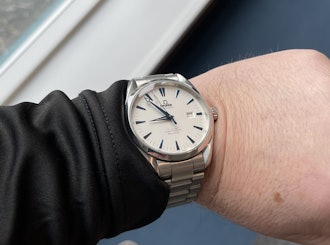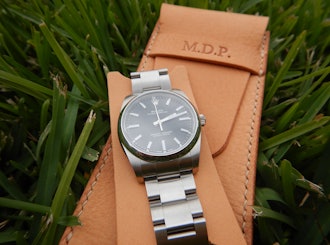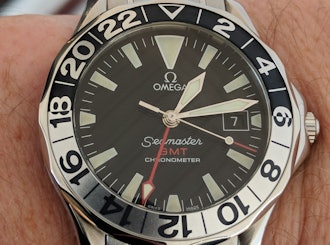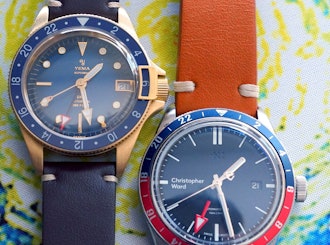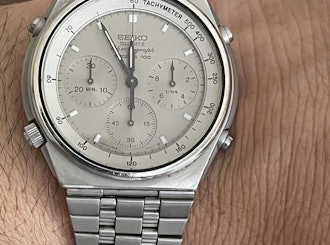Click to view our Accessibility Statement or contact us with accessibility-related questions













Showing 1 of 2 conversations about:

Vintage1982Benz
7977
Jan 16, 2018
bookmark_border
Curious - what took you from watch collector/enthusiast to creating your own pieces and really getting in to mods?

Asheikm
2537
Jan 16, 2018
bookmark_border
Vintage1982BenzShort answer: Curiosity.
Since I can remember I have been curious as to how things work. This leant itself towards making me an avid DIYer. I am still mostly a collector/enthusiast, but when the opportunity presents itself I try to make stuff myself. A simple question, "if someone else can do it, why can't I?" So I try, and sometimes it turns out well. If it doesn't, I learned a lesson. There is also a weird satisfaction of using something that you put together/customized and is exactly as you want it. I also build speakers and amplifiers as a hobby :-)
Tangentially related is the fact that I admire polymaths like Al-Biruni and Leonardo da Vinci. I want to know more about everything. What better way to learn than do.
Since I can remember I have been curious as to how things work. This leant itself towards making me an avid DIYer. I am still mostly a collector/enthusiast, but when the opportunity presents itself I try to make stuff myself. A simple question, "if someone else can do it, why can't I?" So I try, and sometimes it turns out well. If it doesn't, I learned a lesson. There is also a weird satisfaction of using something that you put together/customized and is exactly as you want it. I also build speakers and amplifiers as a hobby :-)
Tangentially related is the fact that I admire polymaths like Al-Biruni and Leonardo da Vinci. I want to know more about everything. What better way to learn than do.

Vintage1982Benz
7977
Jan 17, 2018
bookmark_border
AsheikmAwesome. I've gone as far as opening up case backs and replacing batteries, but have not ventured beyond that. I'd like to try swapping out the crystal on a Seiko or a Vostok or something that wouldn't be a huge hit in terms of cost if it didn't go well.

Gugliermo
1317
Jan 17, 2018
bookmark_border
Vintage1982BenzI can highly recommend getting an Ace Timer. For around $100 you have a fabulous machine that pre digital age watch repairmen could only dream of. Will show you the rate it is running fast/slow, give you amplitude, beat error and other parameters. If you have multiple automatics/hand winders this is well worth it. Will show you exactly their present health and condition. There are two adjustments prongs under the caseback that adjust the speed and beat error, which will also influence the amplitude. With a little trial and error and a few youtube videos you will be able to adjust your own watches. Saves lots and is quite fun.

Asheikm
2537
Jan 18, 2018
bookmark_border
GugliermoInterestingly, I found another way. I use a microphone with a free audio software called Audacity.
When regulating movements: I place the microphone near the balance wheel and record the audio for a few seconds in Audacity. In the software I choose to view the spectrogram of the recording. The beats show up as vertical lines distributed in time/ By zooming in on the lines, I can measure the time between the beats. For a 6Hz (21600bph) movement, the time difference should be 1/6 seconds. From the two levers for adjustment, one controls the period of oscillation (this is the one that should be adjusted when regulating) and the other controls the difference in time between swings in each direction (typically called the isochronism lever). By adjusting the levers, recording audio, and checking the timing, I make sure that the swings are the same and the period is correct. Once I am happy with the result, I record the audio for a longer time (20-30seconds) and make sure the beats are aligned. If fast or slow, I adjust the regulating lever (not the isochronism).
It has worked for me so far.
In fact after I finished this watch, I found that it was running about a minute/day fast. I assume that it was because the movement was previously regulated with slightly larger hands. The lighter hands meant that amplitude of the swing had to be adjusted. The watch is running spot on again ;-).
When regulating movements: I place the microphone near the balance wheel and record the audio for a few seconds in Audacity. In the software I choose to view the spectrogram of the recording. The beats show up as vertical lines distributed in time/ By zooming in on the lines, I can measure the time between the beats. For a 6Hz (21600bph) movement, the time difference should be 1/6 seconds. From the two levers for adjustment, one controls the period of oscillation (this is the one that should be adjusted when regulating) and the other controls the difference in time between swings in each direction (typically called the isochronism lever). By adjusting the levers, recording audio, and checking the timing, I make sure that the swings are the same and the period is correct. Once I am happy with the result, I record the audio for a longer time (20-30seconds) and make sure the beats are aligned. If fast or slow, I adjust the regulating lever (not the isochronism).
It has worked for me so far.
In fact after I finished this watch, I found that it was running about a minute/day fast. I assume that it was because the movement was previously regulated with slightly larger hands. The lighter hands meant that amplitude of the swing had to be adjusted. The watch is running spot on again ;-).

Asheikm
2537
Mar 19, 2019
bookmark_border
GugliermoHello friend!
Haven't seen a wrist check from you in a long time. Hope all is well.
Related Posts
TwentySixAnd
Wrist Check
I thought I would join in on the final posts with my first post of my 'new' watch. I bought my OP one year ago, almost to the day. It's the watch I wear the most (it has a few more love scratches...
Mar 22, 2021

Truelove1
Wrist Check
Soooo..... As I sign off one last time, I thought it fitting to post one of my all time favorites. I’ve had an absolute blast with all of my watch family(you know who you are). I wish each and...
Mar 22, 2021

WathingTime
Wrist Check
My last post for Watch community and the last question to consider. Bronze or steel, blue or black, England or France. Yema Superman GMT Bronze or Christopher Ward Trident GMT. Something to ponder...
Mar 21, 2021
Trending Posts in More Community Picks

Graham88
Completely surprised by the lack of blade diversity here on Drop...
I’ve been a collector of Blades since before my teens, and a retailer coming up on 15… or maybe 20 years. Drop has really been kind of an interesting experience for me, because I do occasionally get to see some unusual tech and sometimes EDC items that otherwise I might not have been aware of. And maybe it’s because I have a deep love of cutlery and bladed weapons, but I find myself trolling through the site looking at it what’s available; and it’s just it’s pretty much the same. And the bladed community here is just always confused me.. every single knife is about the same, they’re almost all drop points and although the handle materials change and brands change.. it’s really just the same knife over and over and over again... occasionally you’ll see a tanto or a slight variant; but rarely… and almost never a serrated blade. And I’m just deeply amazed at this diversion of serrated blades. And I’m just surprised there isn’t more of a request for diversity here.... and I...
Mar 12, 2020
JellyDPhoto
Can we get Sony E-Mount or other mirrorless camera options please..
Would be nice to see some Sony E mount full frame cameras on here. I currently shoot with a A99 and they killed the lense path for better or more option lenses and now is all E-Mount. 🤔
Jan 13, 2020
RayF
There Are Pandas, and Then There Are Pandas.
And this isn't either of them! The Pandas we're talking about here, are watches, not bears. And what got me thinking about them (again) was a link posted this morning by @cm.rook who pointed a few of us to the very attractive (and not terribly priced) Yema "Rallygraph" Panda which, in it's most traditional arrangement, looks like the one on the left, but can also be had in the version on the right: The model on the left is a true Panda, while the model on the right is called a reverse Panda. The reason for that distinction is clear--Panda bears, only come in the first arrangement. Now at this point, everyone should be thinking about the most well-know Panda, The Rolex Panda, which is actually a Daytona, and among Rolex Daytonas, the most famous of which is the Paul Newman Daytona, which was famous first, because it was Paul's, and second because it sold at auction for $17.8 million (US Dollars). The story of that auction is well-known so I'll only...
Nov 8, 2019



